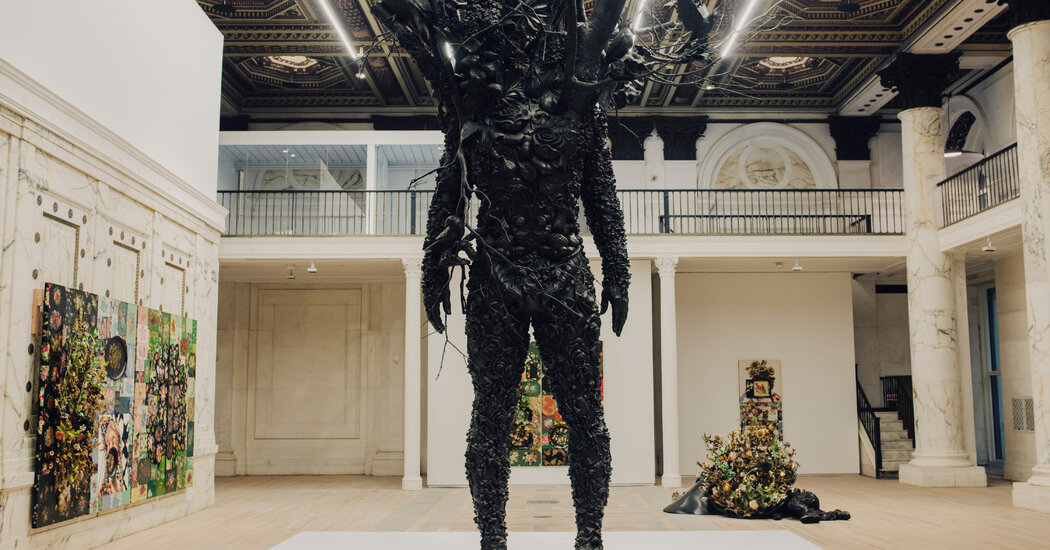The typical gallerist moving to TriBeCa spends a small fortune making their new space look like the derelict former warehouses that originally drew artists downtown because they were cheap. It’s the kind of contradiction that makes the art world what it is — an over-the-top luxury business with a disingenuous devotion to Minimalism. But it can feel a little grating sometimes, and that’s why I was so delighted with the frank ostentation of Jack Shainman Gallery’s new TriBeCa flagship at 46 Lafayette Street, and of its complementary opening show, “Nick Cave: Amalgams and Graphts.”
Instead of looking merely to the 1960s, Shainman has jumped all the way back to the Beaux-Arts 1890s, when less wasn’t yet more, and sited his new flagship in the landmark Clock Tower Building. Formerly known as the New York Life Insurance Building, the blocklong structure was designed by the architect Stephen D. Hatch and completed, after Hatch’s death in 1897, by McKim, Mead & White. Shainman’s new main exhibition space is this building’s magnificent “bank hall,” which features titanic white marble columns, sweeping staircases and an intricately molded, 29-foot-high coffered ceiling.
Additional exhibition spaces in the building include a former meeting room renovated, under the lead of Shainman’s husband, the painter Carlos Vega, working with the architect Gloria Vega Martín and the preservation specialists Higgins Quasebarth & Partners, to have entirely rounded corners and edges, and a secondary, street-level gallery on Broadway with a uniquely sinuous wall. Altogether Shainman has taken over 20,000 square feet, complete with offices, viewing rooms and many dramatic views of the courthouses and municipal buildings around Foley Square.
Towering over the middle of the hall is Nick Cave’s new bronze sculpture “Amalgam (Origin),” a barefoot figure wrapped in flowers and leaves that almost scrapes the ceiling. Instead of a head, a dense cluster of twigs and limbs grows from its shoulders; atop many of these branches sit stately birds. Modeled digitally, combining a scan of the artist’s 65-year-old body with scans of found Syroco ornaments and bird sculptures, before being printed in wax and cast in bronze, the piece is Cave’s largest to date; the highly detailed hands and feet were cast directly from his own.
Cave began making his costume-like “Soundsuits,” seen recently in a major show at the Guggenheim, as a response to the 1991 beating of Rodney King, and he’s made a career-long project of using his own body to explore representations of Black male identity. And there’s an undeniable charge in scaling that impulse up so dramatically, in putting this nearly 26-foot-tall Black man, rendered as an expansive, poetic monument, in the middle of a major art gallery.
At the same time, you only get so much mileage out of a conceptual premise if the aesthetics aren’t equally considered, and I wasn’t convinced that “Amalgam (Origin),” as a sculpture, does enough with its material or scale. If Cave had built the whole thing from hand, or even just attached the actual found ornaments and branches to a 3-D printed figure, instead of scanning them, it might have been a more powerful statement.
“Amalgam (Plot),” on the other hand, in which two smaller figures sprawl on the floor nearby, as if reeling from a violent attack, with a brilliant cluster of metallic flowers and leaves in their own multifarious textures and colors growing up out of them, is shocking and arresting. And “A·mal·gam,” from 2021, a seated bronze on the other side of the building, with a cluster of branches like that in “Amalgam (Origin),” is actually more striking precisely because it’s smaller — the contrast between the lifelike quality of the more or less life-size figure and the frozen, funereal metal in which it’s cast is very evocative.
I was fully engaged, too, as I walked around the hall and the secondary galleries upstairs, by the door-size collages of found tin-plate or tole serving trays that Cave calls “graphts.” These do everything the large bronze promises, offering easily accessible pleasure that doesn’t evaporate when you look at it too long. Some of the pieces include large needlepoint portraits of Cave’s own face — the first time, the news release notes, he’s ever depicted himself so explicitly — and several include clusters of more found decorative flowers and leaves welded together into bouquets.
The graphts have their undertone of political or conceptual meanings, if you want them — their nods to questions about service and class and race. And turning serving trays decorated by anonymous, long-lost artisans into blue chip art, Cave underlines the arbitrary way we assign value to artifacts; including his own face reminds us that those arbitrary values extend to people, too. But because he orchestrates the graphts’ greens, blacks and pinks with such confidence and generosity, because he’s put together so many different kinds of flowers with so many precise three-dimensional accents, their sheer visual complexity is their most important content.
That’s what distinguishes the luxe of the building’s finish, too, from all the other expensive art-world build-outs and renovations you could visit. Like the elements of Cave’s sculptures, the extravagant visual details of the Clock Tower Building gain a fresh new life, even an aesthetic innocence, when they’re decontextualized and remixed. Instead of being broken apart and put back together, as Cave does with his materials, the rosettes and banisters and Corinthian capitals have been replastered, touched up, or reinforced, and the business to which the space is devoted has been updated. But the effect is the same: You feel free simply to enjoy how fabulous it all looks.
Nick Cave: Amalgams and Graphts
Through March 15, Jack Shainman Gallery, 46 Lafayette Street, Lower Manhattan; jackshainman.com.
The post In an Extravagant New Gallery, Nick Cave Goes Big in Bronze appeared first on New York Times.




